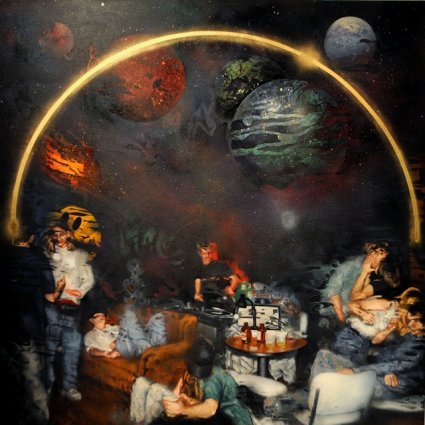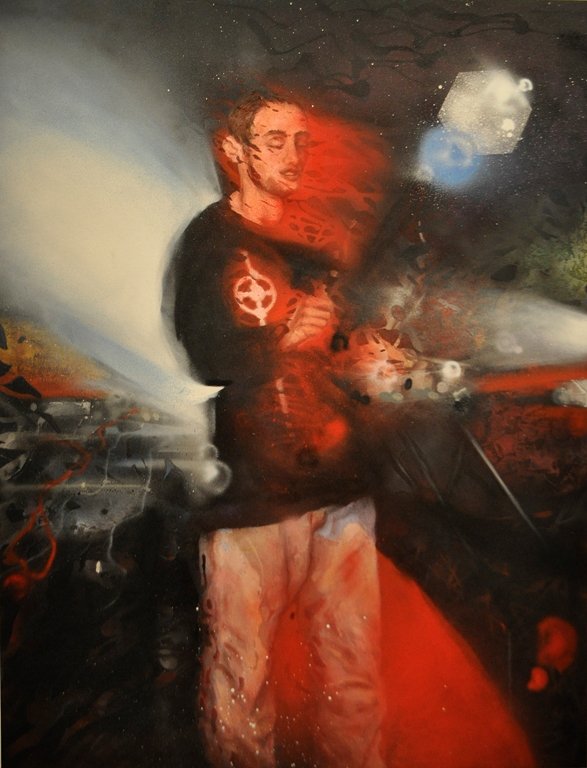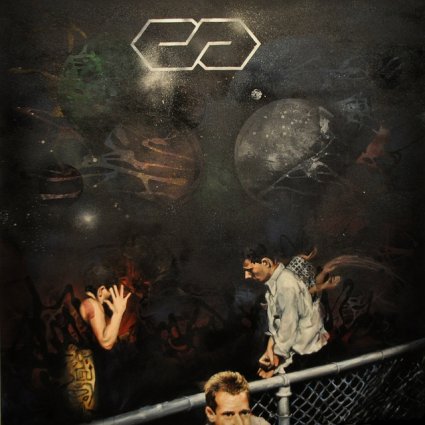Interview by Heike & Robert Dempster
Photos of Jeffrey Noble by Robert Dempster
Photos of the art provided by Jeffrey Noble
Technically, how would you describe your work?
It is very figurative. It is pluralist, in a way. I identify with things that Donald Judd was doing and even though I don’t work minimalist at all, I sample . Perfect. Because I am part of this generation that has the internet and has access to all this information on all these different art periods I can just go research at the click of a button. I am able to sample whatever I want from whatever period of time. I almost think of myself as a DJ sometimes, flipping through albums, sampling and doing these weird match ups. Lately I have been looking at a lot of Francis Bacon because he had the figurative element as well as that gestural, very abstract expressionistic approach.
How does your process work? How much of the finished piece do you see before you put brush to canvas?
I’d have to say it’s 50/50 for the most part. Sometimes I can visualize a piece and it comes out almost exactly how I had planned. Not even almost exactly but it comes out close. And sometimes works really go off on another tangent and divert from my original idea. For the most part I would say about 50/50. I specifically have been working with referential material. The references that I am using have poor quality or have been run through several filters, like a screenshot taken from a conspiracy video that had sampled a movie clip. I take that and do a photo collage in Photoshop and then I use that as my reference. If it is just a really old, poor quality photograph or something like that, I like using that as a source of reference, because it allows me a lot of opportunity to implement my own artistic vision.

You say 50/50. Do you have a preference for either the ones that you didn’t plan that way or the ones that came out exactly as you had envisioned?
It is kind of just like a case by case basis. I would like them to come out but I do like a certain amount of surprises to happen in the work. If it comes out less like what I have planned, I am totally fine with that. I almost prefer that. I can see that as I grow as an artist I start to allow more and more of that to happen. More chance to be involved in the process. Right now, there is still a pretty good amount of control exercising over the works I think.
You have been traveling a lot since graduation from New World School of the Arts. How did that affect your work? What did you take away from it?
I went to several different places. First, I went off to Texas with the Chinati Foundation, which is a foundation that was set up by Donald Judd, the minimal sculptor. Marfa, Texas. It is in the middle of the desert. It is three hours from anywhere. Being out there in that landscape was very, very different. A very different environment. It was inspiring in a lot of ways. I am really into these mid-century artists like Donald Judd and the minimal sculptors. Especially the work I am working on now doesn’t really have much in common with them. There is something maybe about what they were interested in. Their fascinations. Reading about them. Reading some of Donald Judd’s writings, I could really relate to some of the things that he says. That was just a brief trip. After that I followed by going to Europe and I went through Italy and did Venice, Florence and Rome with my graduating class. Then, I went off on my own afterwards to Berlin, Amsterdam and Vienna, Austria. I have to say, Italy definitely impacted me the most because I was seeing all the historical paintings, sculptures, architecture. All the work of the masters. It is all within the Western canon of art making. It has always been something that I wanted to see in person and I had the chance to. There were some things that I saw and I thought, oh, that’s not as impressive as it is made out to be, and then there were some things I had never even heard of before, that I was completely floored by.
You have to give us examples. What did you see that you expected to be great and it was not and what were you amazed by that you had never heard of?
I gotta say the Sistine Chapel. So much hype around it. The fact that it is a fresco is amazing. He was painting it on his back onto the ceiling, but it is not as impressive. The anatomy is not that tight. A lot of the figures are kind of disproportioned and whatnot. Maybe it has to do with the context in which you are viewing it. It was kind of dark in the room, looking up, and crowded with a lot of people. You kind of have been walking through the entire Vatican already and it is kind of one of the last things you get to. You are crammed in there with a bunch of people like sardines so that doesn’t make it quite as enjoyable, I think. As far as something that I did not know much about that turned out, was the Tintoretto paintings. He has a lot of ceiling pieces in Venice in the Doge’s Palace and whatnot. His paintings are oil paintings so they are done on canvas and then installed on the ceilings so he wasn’t painting them on his back or anything like that, but they are still amazing. I think he was very much ahead of his time and set a precedence for how the work is painted. So much of what he was doing was so gestural. Very implied. I could really take apart the layers of how he was creating these paintings and that’s something I was really, really into viewing as a painter.

What are you currently working on?
I have got too much going on. Right now, I am working on a bunch of projects for a bunch of other people. That’s basically how it goes since graduating school and finishing my student life, for now at least. I have been lucky enough to be working around a lot of art and with other artists, whether that is working for the museums, collections or assisting people. I just came from assisting Typoe. He is one of my best friends and he introduces me to a lot of people. One of the reasons I moved here to Miami.
Where are you from?
I grew up in Melbourne, Florida. 321
Some of your new paintings have a dark aspect. What inspires that?
I am entertained by the fact that I lived through multiple manifestations of apocalyptic fear. We had Y2K where people thought the world was going to end cause the computers were going to crash. Now we have had 2012 where everyone thought the world was going to end because of the Mayan calendar. I love that we constantly think there is going to be an end to this shit. I don’t want to get into my religious or spiritual believes or anything like that but I think that that is a very, very fascinating aspect of life that we constantly have to search for I don’t know. We keep subscribing to this fear that we are going to stop and this is going to end and that something bad is going to happen. I just don’t think that that is something you should concern yourself with but I love concerning myself with the stories surrounding it. It is bizarre.
Could you tells us more about your new series of paintings please?
With these new paintings I am working towards an exhibition. I will have a show at Butter Gallery. We are shooting for mid-April. We have not set a date yet. It is still in the works. Paco of Butter Gallery has been great to work with. He is giving me the freedom of not having a deadline. Even though, most times I work better with a deadline. As I said before, I pick a lot of imagery that is based on poor quality photographs. It allows opportunity for me explore other things in paint. I don’t have to stick so closely to the referential image. The photos for this series are from the late 80s and early 90s. All the images I am choosing are kind of from that period. The images are from a friend of mine back in Melbourne. He is kind of a local legend where I am from. For various reasons. His name is Mike Webber. I used to see him driving around town all the time and you couldn’t miss him because he drives these old beat up trucks and he piles junk in the back of his trucks, taller than the cab. This stuff, you think it is a hazard when you see him driving around. He spray paints all over it and stuff. It is a real eyesore but I love it. I think it looks great. He has got a whole fleet of them. He is just known as the junkman in my town. One time I was painting a wall with Typoe and he pulls up in his truck and he asks is we want to paint his truck. We did some quick graffiti, like our names or something like that, and then he takes off. I bumped into him again after about a month or so and he hands me these photographs he took of the trucks and they had kind of this old quality and I actually held on to them for a couple of years. I was looking for something to work with in one of my painting classes and I found those photographs so I thought, why don’t I paint those trucks? I thought it was kind of interesting, like this inception thing, where I painted the truck and he took a photograph of it, giving it back to me and
then doing a painting of the photograph of what I painted on his truck. I kind of hope that these other references almost function in the same way because they are his photographs that he took in the late 80s and early 90s. It is basically just like the bar and club scene in my hometown of Melbourne. Growing up with older siblings and being around older people, you hear stories about these places like the old Mars Club or Coconuts. I was born in 1987, so I am interested in the climate of that time.
Do you know the people in the photographs?
Some of them yes and some of them no. Many of the people, I have no idea who they are, but some of them, every once in a while, I would be going through his photos and I would be able to recognize someone, like my friend’s dad. That’s kind of cool when that happens. It is funny that you bring that up. I have an image of Moby in 1993. He passed through central Florida and played a show. That was probably before he was big or well known.
Is central Florida in the 80s and 90s the theme for the exhibition?
I guess so. What interests me about this specific time period are the people and technology. My generation has been the first generation that has gown up with the internet. We have access to the web everywhere we go. We grew up with a lot of things, a lot of information, that wasn’t immediately available to generations that preceded us. Growing up in a globalized world. I think that something about that is the reason why I am painting these people from this time. There is a historical stamp that is going to be on that time right there.
Do you even remember a time without cell phones?
I do. I think my interest in this period, too, is because a lot of my peers don’t have the same sort of affinity and understanding for that period. I have siblings that are like 10 years older than me so they were influencing me, turning me on to punk when I was really young and exposing me to a lot of things. For various reasons my mom kind of kept things away from us for a while. I don’t think I got a cell phone until I was a senior in high school. We didn’t have cable TV. We were watching reruns from the antenna of Seinfeld or The Cosby Show. We didn’t have any video games. We were not allowed to play video games. I kind of feel more at home at that time. Am I confusing this with a sense of nostalgia that I might have? Cause that’s another thing I feel my generation is so hung up on, is this nostalgia for things before. Look at what Instagram is. It is a super technically advanced way of communicating and sharing but it is completely rooted in throwing a little filter on a photograph that makes it look old or trendy. We have this really deep nostalgia for things we did not really experience first hand. Look at music. Any music. All this really folky sounding independent stuff. I bet it has something to do with that as well. I paint pictures because I don’t know how to talk about it. But that’s what I was thinking about.

 Heike Dempster
Heike Dempster